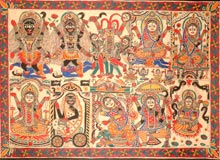 Madhubani paintings, also referred as Godhna, Maithili and Chitra figure paintings are renowned worldwide for their beauty and simplicity. The art is originated from the small region of Bihar in Madhubani. The exact beginning of the painting is still unknown. According to the traditions, the painting originated in the Ramayana period when King Janaka invited the painters to paint the marriage of Lord Rama and Sita.
Madhubani paintings, also referred as Godhna, Maithili and Chitra figure paintings are renowned worldwide for their beauty and simplicity. The art is originated from the small region of Bihar in Madhubani. The exact beginning of the painting is still unknown. According to the traditions, the painting originated in the Ramayana period when King Janaka invited the painters to paint the marriage of Lord Rama and Sita.Initially the people of Maithil region do painting only for the decorative purpose and this art was not commercialized. However after 1960s, the famine and flood led to the commercialization of this art.
The painting now began to be executed on cloth, satin, sarees etc instead of walls. However the original theme which was chiefly religious was never abandoned.

How it is done?
Cow dung paste and mud is applied on the walls and floors to give a perfect black background
 on which pictures are drawn with white rice paste; bright vegetable colors are then applied on the figures making them more vibrant. A great number of Madhubani painters still apply a thin layer of cow dung and mud paste on their canvases to give a more authentic look and also because it helps in proper absorption of color.
on which pictures are drawn with white rice paste; bright vegetable colors are then applied on the figures making them more vibrant. A great number of Madhubani painters still apply a thin layer of cow dung and mud paste on their canvases to give a more authentic look and also because it helps in proper absorption of color.Madhubani is a style of painting that employs natural colors and the most popular one include deep red derived from Kusuma flower, green from Bel trees, black from burnt jowar, light yellow from turmeric mixed with banyan leaf milk and orange from Palasa flower. The brush for painting is unusual and is handmade.
It is a Feminine Art
Madhubani painting is the work of women folk of Madhubani. This art has been practiced since many centuries. After getting respite from daily chores, the women of Madhubani portray figures from nature and myth on the fabrics. Nowadays this art is now not limited to women only as lots of men are also undertaking this practice.

Themes of Madhubani painting
The themes of Madhubani paintings mainly revolve around religion and mythology. These themes can be grouped into two- little tradition and great tradition. The little tradition painting includes Gods like Raja Salesh, Buddheshwar, Jutki Malini, Reshma, whereas the Great tradition is a tribute to the Hindu Gods like Krishna-Radha, Shiva-Parvati, Ganesha, Maa Durga, and the likes. Apart from this the artist also extract the theme from the nature and the village surroundings.
Other themes of the Madhubani paintings are celestial subjects like Sun and Moon. The holy Tulsi plant is also regularly featured in these paintings. These paintings also beautifully depicts court scenes, wedding scenes and social happenings. Intricate floral, animal and bird motifs, and symmetrical geometric designs fill up the gaps.

Features of Madhubani Paintings
The main features of Madhubani paintings are:
- Colors used are bold, natural and artificial colors.
- Border is double lined having simple geometric designs or with ornate floral patterns on it
- The main theme is supported by symbols, lines and patterns
- The painting also sometimes shows abstract-like figures, of deities or human
- The faces of the figures depicted on the canvas have large bulging eyes and a jolting nose emerging out of the forehead.

2 comments:
i appreciate the effort put in for the research, furnishing of the details and the important characteristics.
Wow the way u've explained is really great,it takes me to the real places,i cud feel the painting from my soul....can u post me some madhubani patterns/pictures?i wanted do one long before,but cudnt find one catchy picture...if u can pls post it...looking forward for ur madhubani pics...
Post a Comment